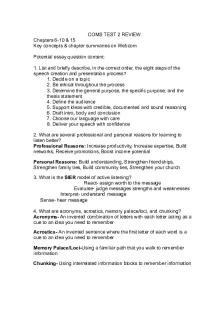COMS 101 Test 2 Review PDF

| Title | COMS 101 Test 2 Review |
|---|---|
| Course | Speech Communication |
| Institution | Liberty University |
| Pages | 3 |
| File Size | 74.3 KB |
| File Type | |
| Total Downloads | 11 |
| Total Views | 146 |
Summary
Download COMS 101 Test 2 Review PDF
Description
COMS TEST 2 REVIEW Chapters 6-10 & 15 Key concepts & chapter summaries on Webcom Potential essay question content: 1. List and briefly describe, in the correct order, the eight steps of the speech creation and presentation process? 1. Decide on a topic 2. Be ethical throughout the process 3. Determine the general purpose, the specific purpose, and the thesis statement 4. Define the audience 5. Support ideas with credible, documented and sound reasoning 6. Draft intro, body and conclusion 7. Choose our language with care 8. Deliver your speech with confidence 2. What are several professional and personal reasons for learning to listen better? Professional Reasons: Increase productivity, Increase expertise, Build networks, Receive promotions, Boost income potential Personal Reasons: Build understanding, Strengthen friendships, Strengthen family ties, Build community ties, Strengthen your church 3. What is the SIER model of active listening? React- assign worth to the message Evaluate- judge messages strengths and weaknesses Interpret- understand message Sense- hear message 4. What are acronyms, acrostics, memory palace/loci, and chunking? Acronyms- An invented combination of letters with each letter acting as a cue to an idea you need to remember Acrostics- An invented sentence where the first letter of each word is a cue to an idea you need to remember Memory Palace/Loci-Using a familiar path that you walk to remember information Chunking- Using interrelated information blocks to remember information
5. List six reasons why knowing your audience matters. 1. audience needs should shape your topic choice 2. audience needs should shape your specific purpose 3. research strategy 4. speech verbal language 5. speech’s nonverbal language 6. presentational aids 6. List three reasons to avoid stereotyping an audience. 1. what they assume to be true about someone is based on uninformed hunch rather than evidence 2. They can make a speech irrelevant and diminish the speakers credibility 3. They are potentially destructive in their effect on people 7. Present Dr. Alban’s question for sizing up the speaking situation as you prepare a speech. For which particular purpose will this particular speaker (I) send this particular message—delivered in this particular manner and in this particular form—to this particular audience, with its particular expectations, at this particular time and place under these particular circumstances? 8. List six keys for reaching an audience. 1. Successful planners avoid the age gap 2. Successful planners jettison gender stereotypes 3. Successful planners determine how much their audience knows. 4. Successful planners know the group. 5. Successful planners recognize the importance of considering the audience’s lifestyle choices and attitudes, beliefs, and values. 6. Successful planners consider why their audience is an audience. 9. Define a credible source. A credible source is a person or an organization with documentable experiences or credentials that clearly qualify the source to speak as an authority about a specific issue or experience. 10. Identify where you can find credible sources. Media(print,electronic,digital): Books, journals, magazines, credible websites, academic databases. Direct: Documented, recorded interviews
11. Identify and define several types of verbal and nonverbal support Verbal Supports Facts, Statistics, Examples, Expert testimony, Analogies, Definitions, Fables, Sayings, Poems, and Rhymes
Non-Verbal Supports Computer graphics, Charts, Maps, Models, Pictures...
Similar Free PDFs

COMS 101 Test 2 Review
- 3 Pages

COMS 101: COMMUNICATION SKILLS
- 5 Pages

101 Test Review
- 3 Pages

COMS 356 - Discussion Forum 2
- 1 Pages

CRR Test 2 Review
- 12 Pages

Ntr test 2 review
- 6 Pages

Microbiology Test 2 Review
- 19 Pages

Oceanography Test 2 Review
- 4 Pages

Chemistry Test 2 Review
- 22 Pages

Test 2 Review Sheet
- 3 Pages

Pharm Test 2 Review
- 12 Pages

251 Test 2 Review
- 2 Pages

BBH 101 Exam 1 Review Sheet-2
- 6 Pages

Accounting 101 for review
- 21 Pages
Popular Institutions
- Tinajero National High School - Annex
- Politeknik Caltex Riau
- Yokohama City University
- SGT University
- University of Al-Qadisiyah
- Divine Word College of Vigan
- Techniek College Rotterdam
- Universidade de Santiago
- Universiti Teknologi MARA Cawangan Johor Kampus Pasir Gudang
- Poltekkes Kemenkes Yogyakarta
- Baguio City National High School
- Colegio san marcos
- preparatoria uno
- Centro de Bachillerato Tecnológico Industrial y de Servicios No. 107
- Dalian Maritime University
- Quang Trung Secondary School
- Colegio Tecnológico en Informática
- Corporación Regional de Educación Superior
- Grupo CEDVA
- Dar Al Uloom University
- Centro de Estudios Preuniversitarios de la Universidad Nacional de Ingeniería
- 上智大学
- Aakash International School, Nuna Majara
- San Felipe Neri Catholic School
- Kang Chiao International School - New Taipei City
- Misamis Occidental National High School
- Institución Educativa Escuela Normal Juan Ladrilleros
- Kolehiyo ng Pantukan
- Batanes State College
- Instituto Continental
- Sekolah Menengah Kejuruan Kesehatan Kaltara (Tarakan)
- Colegio de La Inmaculada Concepcion - Cebu

